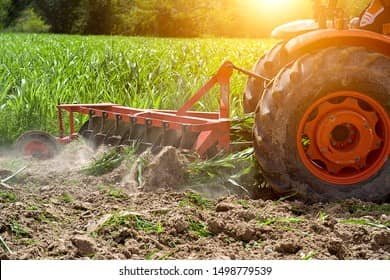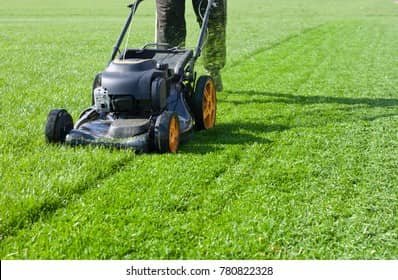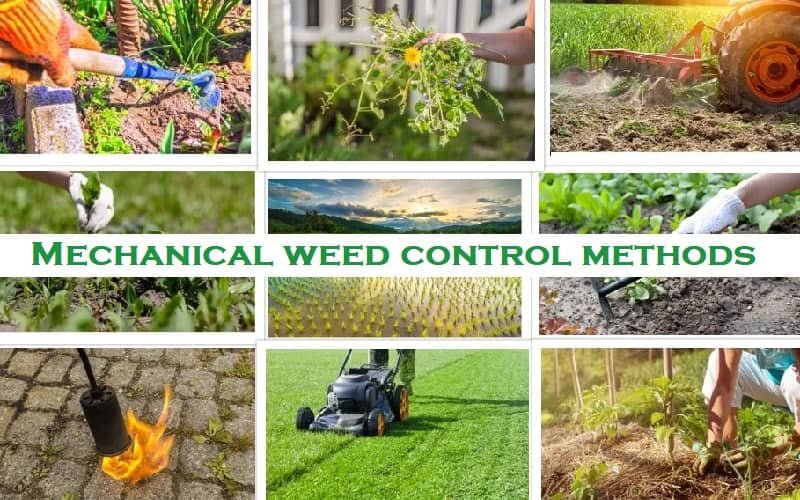Mechanical Weed Control Methods
Mechanical (Sometimes called Cultural/Physical) methods of weed control are being employed ever since man began to grow crops. Many agricultural practices are dictated by the need for weed control. Although herbicides are fast replacing traditional weed control methods, mechanical methods are very much needed to make weed control more effective and economical. The mechanical techniques include tillage, sickling, hoeing, hand weeding, digging, mowing, burning, flooding, mulching, etc.
1. Tillage:

Tillage removes weeds from the soil, resulting in their death. It may weaken plants through injury or root and stem pruning, reducing their competitiveness or regenerative capacity. Tillage also buries weeds. Besides controlling weeds, tillage affects the physical condition of the soil. Simple plowing helps you buried of annual, biennial, and many perennial weeds. The essential tillage implements are the plow, harrow, etc. The type of implement needed for most effective weed control depends upon the weed species, underground root system, age of the weed, etc.
2. Hoeing:

Hoe has been the most appropriate and widely used weeding tool for centuries. “The man with the hoe,” which symbolized weed control centuries, is being replaced by “The man with sprayer.” Hoe, however, is still a handy implement to obtain results effective and cheaply. Hoeing is particularly more effective on annuals and biennials as weed growth can be completely destroyed.
3. Hand weeding:

Hand weeding is done by physical removal or pulling out of weeds by hand or removal by implement called khurpi, which resembles a sickle. It is probably the oldest method of controlling weeds, and it is still a practical and efficient method of eliminating weeds in cropped and non – cropped lands.
4. Digging:

Digging is very useful in perennial weeds to remove the underground propagating parts of weeds from the deeper layers of the soil. This practice is more effective than hand pulling. Digging is accompanied by hand pulling of the plant. Hand pulling without proper digging results in removing top growth only, allowing regrowth from the leftover plant parts.
5. Sickling and mowing:

Sickling is also done by hand with the help of a sickle to remove the top growth of weeds, prevent seed production, and starve the underground parts. Sickling is also done to reduce mature perennial weed growth.
Mowing is a machine-operated process mostly done along the roadside and on lawns. Its objectives are the same as that of sickling.
6. Burning:

Burning or fire is often an economical and practical means of controlling weeds. It is used to
- Dispose of accumulated vegetation
- Destroy dry tops of weeds that have matured.
- Kill green weed growth.
- To destroy the buried weed seeds.
Fire is used to burn crop residues in cotton, sugarcane, potatoes, corn, soybean, sorghum, castor, etc.
7. Flooding:

Flooding is sometimes used for weed control in rice. Which can grow under flooded conditions. Flooding kills plants by reducing oxygen availability for plant growth. The success of flooding treatment depends upon the complete submergence of weeds for long periods.
8. Mulching:

Mulching is the method of covering the soil with some organic or inert materials such as straw, sawdust, bark dust, and other plant parts of various sizes. It is also done by paper, plastic sheets, or polythene. So mulching is practical on a small scale in some areas to check the growth of weeds.
Merits of Mechanical Method
- Oldest, effective and economical method
- A large area can be covered in a shorter time
- A safe way for the environment
- Does not involve any skill
- Weeding is possible in between plants
- Deep-rooted weeds can be controlled effectively
Demerits of Mechanical Method
- Labor consuming
- Possibility of damaging crop
- Requires ideal and optimum specific condition
